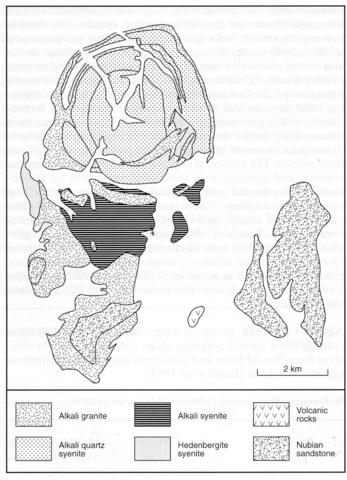stripes
This complex is emplaced mainly in Precambrian biotite gneisses and is overlain in places by thin remnant patches of Nubian Sandstone. A small area (0.1 km2) of volcanic rocks lies to the south-southeast of the complex and comprises ignimbrites, flow-banded rhyolitic lavas and pyroclastics. The northern part of the complex consists of a series of ring-dykes with a central plug and a major stock to the south. There appears to have been substantial subsidence along outward-dipping ring faults. The oldest rocks are hedenbergite syenites which are present in several relatively small areas. They are coarse-grained or porphyritic rocks with perthite phenocrysts in a groundmass of perthite and a little quartz. There is some hedenbergite, which is occasionally zoned to aegirine-hedenbergite, and often replaced by actinolite, which also forms discrete grains and may be associated with a little sodic amphibole; biotite is also present. Peralkaline syenite forms a large arcuate intrusion on the south side of the main ring complex, as well as the two major rings and a central plug. All these syenites contain quartz, some coming close to granite in composition, together with perthite and both sodic pyroxene and amphibole. Aegirine, commonly zoned, replaces amphibole which is generally interstitial and often zoned from arfvedsonite cores to riebeckite rims; poikilitic ferrorichterite is present in chilled varieties. The largest single unit is the granite forming the southern end of the complex. Granite also forms two ring-dykes which coalesce on the western side of the complex. These ring-dykes post-date all the syenites and are the youngest rocks of the intrusion. The granites consist of prismatic perthite, which is commonly granophyrically intergrown with quartz and aegirine, which is later and more abundant than arfvedsonite and riebeckite and may comprise as much as a quarter of the rock. Aegirine is strongly zoned and commonly has a radiating habit; in finer-grained varieties it may be poikilitic towards feldspar and quartz. Cone-sheets, narrow ring-dykes and radial dykes are common within the complex and the country rocks. They are principally peralkaline granites but a few of syenite as well as intrusive tuff also occur. There is a major cone-sheet swarm concentrated to the north and west of the complex which appears to pre-date the main ring complex. Phenocrysts are quartz and alkali feldspar with sodic pyroxene and amphibole being interstitial only. Rock analyses for major and trace elements are available in O'Halloran (1985a).
BARTH, H., BESANG, C., LENZ, H. and MEINHOLD, K.-D. 1983. Results of petrological investigations and Rb/Sr age determinations on the non-orogenic igneous ring-complexes in the Bayuda Desert, Sudan. Geologisches Jahrbuch, 51: 1-34.O'HALLORAN, D.A. 1985a. Structure, petrology and geochemistry of the Abu Dom alkaline ring-complex, Bayuda Desert, Sudan. Geological Journal, 20: 301-17.


